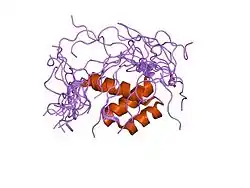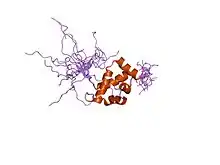SATB2
Special AT-rich sequence-binding protein 2 (SATB2) also known as DNA-binding protein SATB2 is a protein that in humans is encoded by the SATB2 gene.[5] SATB2 is a DNA-binding protein that specifically binds nuclear matrix attachment regions and is involved in transcriptional regulation and chromatin remodeling.[6] SATB2 shows a restricted mode of expression and is expressed in certain cell nuclei . The SATB2 protein is mainly expressed in the epithelial cells of the colon and rectum, followed by the nuclei of neurons in the brain.[7]
Function
With an average worldwide prevalence of 1/800 live births, oral clefts are one of the most common birth defects.[8] Although over 300 malformation syndromes can include an oral cleft, non-syndromic forms represent about 70% of cases with cleft lip with or without cleft palate (CL/P) and roughly 50% of cases with cleft palate (CP) only. Non-syndromic oral clefts are considered ‘complex’ or ‘multifactorial’ in that both genes and environmental factors contribute to the etiology. Current research suggests that several genes are likely to control risk, as well as environmental factors such as maternal smoking.[9]
Re-sequencing studies to identify specific mutations suggest several different genes may control risk to oral clefts, and many distinct variants or mutations in apparently causal genes have been found reflecting a high degree of allelic heterogeneity. Although most of these mutations are extremely rare and often show incomplete penetrance (i.e., an unaffected parent or other relative may also carry the mutation), combined they may account for up to 5% of non-syndromic oral cleft.[9]
Mutations in the SATB2 gene have been found to cause isolated cleft palates.[10] SATB2 also likely influences brain development. This is consistent with mouse studies that show SATB2 is necessary for proper establishment of cortical neuron connections across the corpus callosum, despite the apparently normal corpus callosum in heterozygous knockout mice.[11]
Structure
SATB2 is a 733 amino-acid homeodomain-containing human protein with a molecular weight of 82.5 kDa encoded by the SATB2 gene on 2q33. The protein contains two degenerate homeodomain regions known as CUT domains (amino acid 352–437 and 482–560) and a classical homeodomain (amino acid 614–677). There is an extraordinarily high degree of sequence conservation, with only three predicted amino-acid substitutions in the 733 residue protein with I481V, A590T and I730T being amino acid differences between the human and the mouse protein.
Clinical significance
SATB2 has been implicated as causative in the cleft or high palate of individuals with 2q32q33 microdeletion syndrome.[11]
SATB2 was found to be disrupted in two unrelated cases with de novo apparently balanced chromosome translocations associated with cleft palate and Pierre Robin sequence.[12]
The role of SATB2 in tooth and jaw development is supported by the identification of a de novo SATB2 mutation in a male with profound intellectual disabilities and jaw and tooth abnormalities and a translocation interrupting SATB2 in an individual with Robin sequence. In addition, mouse models have demonstrated haploinsufficiency of SATB2 results in craniofacial defects that phenocopy those caused by 2q32q33 deletion in humans; moreover, full functional loss of SATB2 amplifies these defects.[11]
SATB2 expression is highly specific for cancer in the lower GI-tract and has been implicated as a cancer biomarker for colorectal cancer.[13][14]
References
- GRCh38: Ensembl release 89: ENSG00000119042 - Ensembl, May 2017
- GRCm38: Ensembl release 89: ENSMUSG00000038331 - Ensembl, May 2017
- "Human PubMed Reference:". National Center for Biotechnology Information, U.S. National Library of Medicine.
- "Mouse PubMed Reference:". National Center for Biotechnology Information, U.S. National Library of Medicine.
- Kikuno R, Nagase T, Ishikawa K, Hirosawa M, Miyajima N, Tanaka A, Kotani H, Nomura N, Ohara O (June 1999). "Prediction of the coding sequences of unidentified human genes. XIV. The complete sequences of 100 new cDNA clones from brain which code for large proteins in vitro". DNA Research. 6 (3): 197–205. doi:10.1093/dnares/6.3.197. PMID 10470851.
- "Entrez Gene: SATB homeobox 2".
- Uhlén, Mathias; Fagerberg, Linn; Hallström, Björn M.; Lindskog, Cecilia; Oksvold, Per; Mardinoglu, Adil; Sivertsson, Åsa; Kampf, Caroline; Sjöstedt, Evelina (2015-01-23). "Tissue-based map of the human proteome". Science. 347 (6220): 1260419. doi:10.1126/science.1260419. ISSN 0036-8075. PMID 25613900. S2CID 802377.
- Jugessur A, Shi M, Gjessing HK, Lie RT, Wilcox AJ, Weinberg CR, Christensen K, Boyles AL, Daack-Hirsch S, Nguyen TT, Christiansen L, Lidral AC, Murray JC (2010). "Maternal genes and facial clefts in offspring: a comprehensive search for genetic associations in two population-based cleft studies from Scandinavia". PLOS ONE. 5 (7): e11493. Bibcode:2010PLoSO...511493J. doi:10.1371/journal.pone.0011493. PMC 2901336. PMID 20634891.

- Beaty TH, Hetmanski JB, Fallin MD, Park JW, Sull JW, McIntosh I, Liang KY, Vanderkolk CA, Redett RJ, Boyadjiev SA, Jabs EW, Chong SS, Cheah FS, Wu-Chou YH, Chen PK, Chiu YF, Yeow V, Ng IS, Cheng J, Huang S, Ye X, Wang H, Ingersoll R, Scott AF (November 2006). "Analysis of candidate genes on chromosome 2 in oral cleft case-parent trios from three populations". Human Genetics. 120 (4): 501–18. doi:10.1007/s00439-006-0235-9. PMID 16953426. S2CID 7836461.
- Dixon MJ, Marazita ML, Beaty TH, Murray JC (March 2011). "Cleft lip and palate: understanding genetic and environmental influences". Nature Reviews. Genetics. 12 (3): 167–78. doi:10.1038/nrg2933. PMC 3086810. PMID 21331089.
- Rosenfeld JA, Ballif BC, Lucas A, Spence EJ, Powell C, Aylsworth AS, Torchia BA, Shaffer LG (2009). "Small deletions of SATB2 cause some of the clinical features of the 2q33.1 microdeletion syndrome". PLOS ONE. 4 (8): e6568. Bibcode:2009PLoSO...4.6568R. doi:10.1371/journal.pone.0006568. PMC 2719055. PMID 19668335.

- FitzPatrick DR, Carr IM, McLaren L, Leek JP, Wightman P, Williamson K, Gautier P, McGill N, Hayward C, Firth H, Markham AF, Fantes JA, Bonthron DT (October 2003). "Identification of SATB2 as the cleft palate gene on 2q32-q33". Human Molecular Genetics. 12 (19): 2491–501. doi:10.1093/hmg/ddg248. PMID 12915443.
- Magnusson, Kristina; Wit, Meike de; Brennan, Donal J.; Johnson, Louis B.; McGee, Sharon F.; Lundberg, Emma; Naicker, Kirsha; Klinger, Rut; Kampf, Caroline (2011). "SATB2 in Combination With Cytokeratin 20 Identifies Over 95% of all Colorectal Carcinomas". The American Journal of Surgical Pathology. 35 (7): 937–948. doi:10.1097/pas.0b013e31821c3dae. PMID 21677534. S2CID 33883685.
- Dragomir, Anca; de Wit, Meike; Johansson, Christine; Uhlen, Mathias; Pontén, Fredrik (2014-05-01). "The Role of SATB2 as a Diagnostic Marker for Tumors of Colorectal OriginResults of a Pathology-Based Clinical Prospective Study". American Journal of Clinical Pathology. 141 (5): 630–638. doi:10.1309/ajcpww2urz9jkqju. ISSN 0002-9173. PMID 24713733.
Further reading
- Dobreva G, Dambacher J, Grosschedl R (December 2003). "SUMO modification of a novel MAR-binding protein, SATB2, modulates immunoglobulin mu gene expression". Genes & Development. 17 (24): 3048–61. doi:10.1101/gad.1153003. PMC 305257. PMID 14701874.
- Dobreva G, Chahrour M, Dautzenberg M, Chirivella L, Kanzler B, Fariñas I, Karsenty G, Grosschedl R (June 2006). "SATB2 is a multifunctional determinant of craniofacial patterning and osteoblast differentiation". Cell. 125 (5): 971–86. doi:10.1016/j.cell.2006.05.012. PMID 16751105. S2CID 2882724.
- Alcamo EA, Chirivella L, Dautzenberg M, Dobreva G, Fariñas I, Grosschedl R, McConnell SK (February 2008). "Satb2 regulates callosal projection neuron identity in the developing cerebral cortex". Neuron. 57 (3): 364–77. doi:10.1016/j.neuron.2007.12.012. PMID 18255030. S2CID 6716396.
- Beaty TH, Hetmanski JB, Fallin MD, Park JW, Sull JW, McIntosh I, Liang KY, Vanderkolk CA, Redett RJ, Boyadjiev SA, Jabs EW, Chong SS, Cheah FS, Wu-Chou YH, Chen PK, Chiu YF, Yeow V, Ng IS, Cheng J, Huang S, Ye X, Wang H, Ingersoll R, Scott AF (November 2006). "Analysis of candidate genes on chromosome 2 in oral cleft case-parent trios from three populations". Human Genetics. 120 (4): 501–18. doi:10.1007/s00439-006-0235-9. PMID 16953426. S2CID 7836461.
- Machado RD, Pauciulo MW, Fretwell N, Veal C, Thomson JR, Vilariño Güell C, Aldred M, Brannon CA, Trembath RC, Nichols WC (September 2000). "A physical and transcript map based upon refinement of the critical interval for PPH1, a gene for familial primary pulmonary hypertension. The International PPH Consortium". Genomics. 68 (2): 220–8. doi:10.1006/geno.2000.6291. PMID 10964520.
- Jugessur A, Shi M, Gjessing HK, Lie RT, Wilcox AJ, Weinberg CR, Christensen K, Boyles AL, Daack-Hirsch S, Nguyen TT, Christiansen L, Lidral AC, Murray JC (2010). "Maternal genes and facial clefts in offspring: a comprehensive search for genetic associations in two population-based cleft studies from Scandinavia". PLOS ONE. 5 (7): e11493. Bibcode:2010PLoSO...511493J. doi:10.1371/journal.pone.0011493. PMC 2901336. PMID 20634891.

- Carter TC, Molloy AM, Pangilinan F, Troendle JF, Kirke PN, Conley MR, Orr DJ, Earley M, McKiernan E, Lynn EC, Doyle A, Scott JM, Brody LC, Mills JL (February 2010). "Testing reported associations of genetic risk factors for oral clefts in a large Irish study population". Birth Defects Research. Part A, Clinical and Molecular Teratology. 88 (2): 84–93. doi:10.1002/bdra.20639. PMC 3503531. PMID 19937600.
- Rosenfeld JA, Ballif BC, Lucas A, Spence EJ, Powell C, Aylsworth AS, Torchia BA, Shaffer LG (2009). "Small deletions of SATB2 cause some of the clinical features of the 2q33.1 microdeletion syndrome". PLOS ONE. 4 (8): e6568. Bibcode:2009PLoSO...4.6568R. doi:10.1371/journal.pone.0006568. PMC 2719055. PMID 19668335.

- Vieira AR, Avila JR, Daack-Hirsch S, Dragan E, Félix TM, Rahimov F, Harrington J, Schultz RR, Watanabe Y, Johnson M, Fang J, O'Brien SE, Orioli IM, Castilla EE, Fitzpatrick DR, Jiang R, Marazita ML, Murray JC (December 2005). "Medical sequencing of candidate genes for nonsyndromic cleft lip and palate". PLOS Genetics. 1 (6): e64. doi:10.1371/journal.pgen.0010064. PMC 1298935. PMID 16327884.

External links
- SATB2 human gene location in the UCSC Genome Browser.
- SATB2 human gene details in the UCSC Genome Browser.
Registry of SATB2 cases http://satb2gene.com
This article incorporates text from the United States National Library of Medicine, which is in the public domain.







